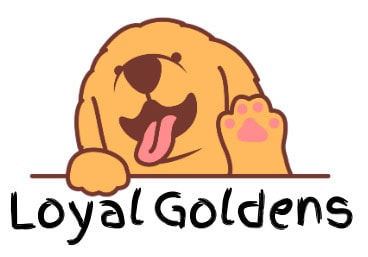Golden Retrievers are among the most popular dogs in the world. While there are three signature types that fall under the Golden Retriever breed, they have five different coat colors between them.
Golden Retrievers are famous for their long, thick, shiny coats, which can vary in colors from cream to dark gold, and even red, depending on the type. Some Golden Retrievers will even change shades as they grow into adults.
In this article, I’ll cover the standard coat colors of Golden Retrievers, as defined by breed clubs, as well as the style of coat and grooming needs. Here we go!
Golden Retriever Coats
Golden Retrievers have a lush and thick double layer coat. The American Kennel Club (AKC) standards for Golden Retrievers require a single coat color, although it’s not uncommon for the feathering (long fur around the legs and tail) to be a shade lighter than the rest of the coat.
However, you will rarely see a Golden Retriever with pure white, true black, or other colors in golden coats. These colored markings are flaws, according to the AKC breed standards. It may be a sign of a mixed breed instead of a purebred Golden Retriever.
Show rings only recognize three coat colors in both America and the UK. If you’re going to want to enter your Retriever in pet shows, your pet will need to be light golden or golden. However, the UK also permits cream-colored Retrievers due to their regional popularity.
However, if your Retriever is just a part of the family, they can be mixed colors and include any of the five shades commonly seen in Golden Retrievers, which are cream, red, dark golden, light golden, and classic gold.
Cream Golden Retrievers
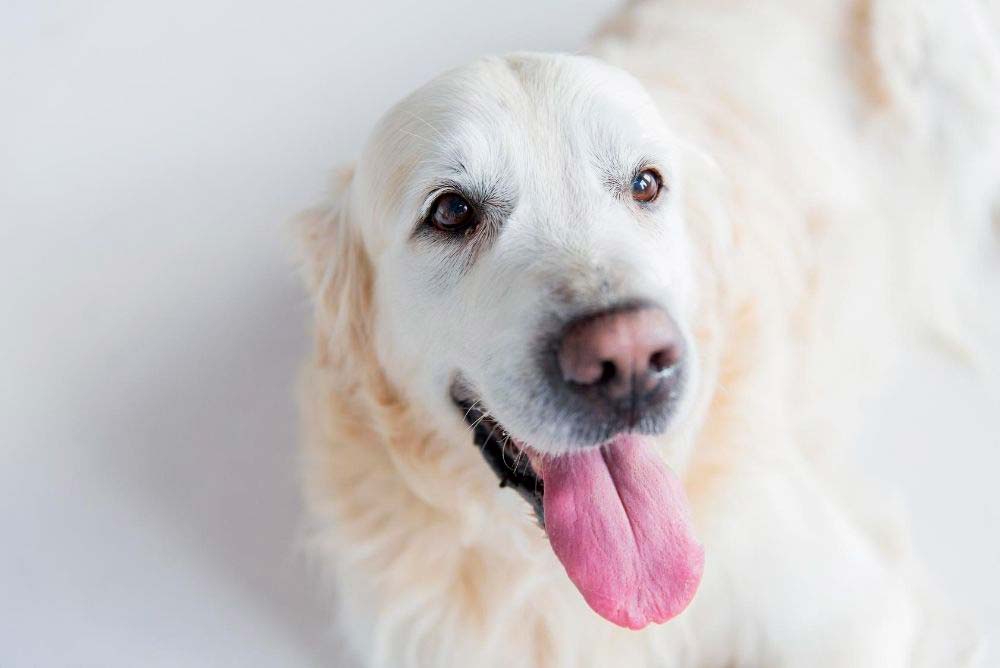
(This article may contain affiliate links and loyalgoldens may earn a commission if a purchase is made.)
Unlock your goldens natural intelligence and see just how quickly problem behaviors disappear.This is the best at home dog training I've ever used!
Cream coated Golden Retrievers are quite popular. These lovely dogs have fur that is so pale brown that it’s almost white (think off-white). Many times, they are often mistaken for Labradors due to similar coat colors and markings.
Cream coats are also thinner than other coat colors, although the shedding pattern will be about the same, there might be a little less hair to clean up around your house.
These dogs are most often referred to as English Golden Retrievers and are more common in the UK than in America.
When it comes to dog shows, the Kennel Club in the UK does permit cream-colored Golden Retrievers, but the American Kennel Club does not.
Avoid Scammers
Be wary of breeders who market Golden Retrievers as “rare,” “platinum,” or “white.” You may hear them referred to as “English Cream Golden,” “Rare White European Golden Retrievers,” or “Exquisite Platinum Imported Golden Retrievers.”
All of these are false marketing claims and are scams to raise prices for a breed that’s already quite popular, just by changing its name.
Red Golden Retriever
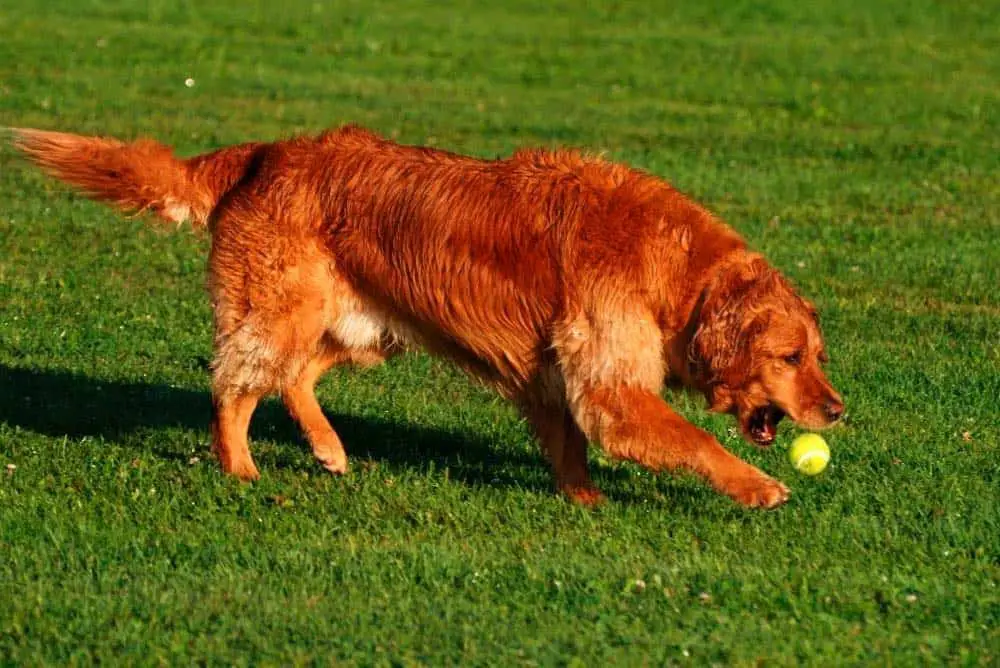
Red Golden Retrievers have a rusty red double layer coat that makes them often mistaken for Irish Setters, which is in their ancestral DNA from when the breed originated.
Most red Retrievers have a shorter, straighter coat, similar to a Lab over a Golden Retriever. The color can vary from a dark rust red to a bright, almost copper color. The fur will be long, wavy, and soft, but it’s not as luscious and thick as traditional Golden Retrievers.
Shedding and grooming are similar to other Golden Retrievers. You should groom your red Retriever at least once a week to remove any loose hair, and more frequently during heavy shedding such as in the fall or spring.
Red Retrievers usually also have less feathering around the tail and limbs. The body of a Red Retriever is more compact or streamlined than other Retriever breeds.
The weight, height, and life expectancy are the same for Reds as they are for all Retrievers (65 – 75 pounds, 22″ – 24″ height and 10-12 year lifespan).
Dark Golden Retrievers
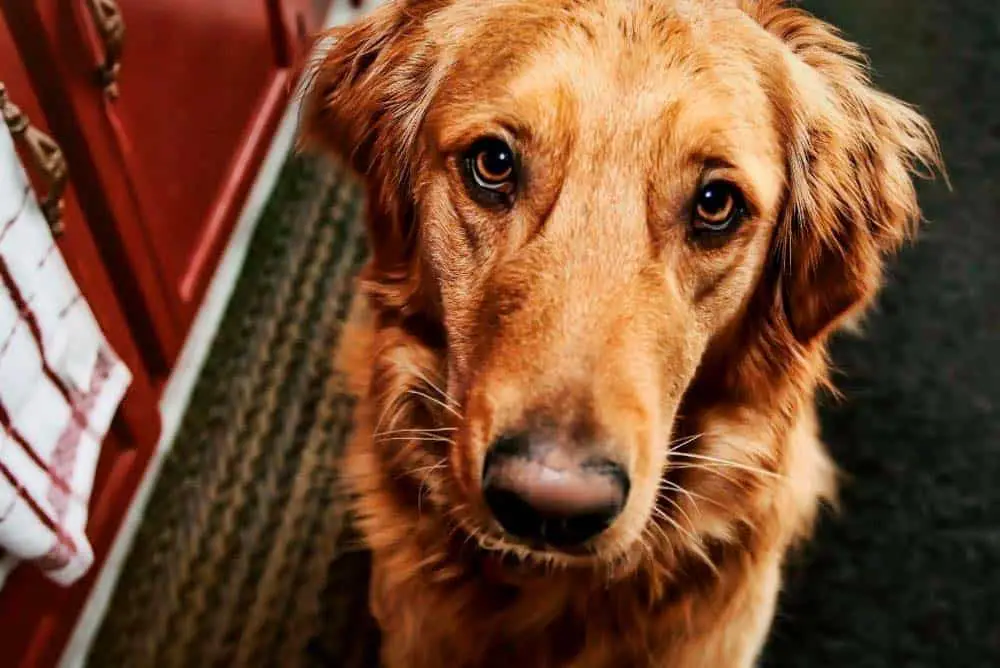
Discover how to train your Golden Retriever by playing games: 21 games to play with your Golden that will make them smarter and better behaved!
It can be challenging to distinguish between a red and dark golden Retriever due to both variations having dark brown or rusty colored coats. However, Dark Golden Retrievers do not have an amber or red hue in their double layer coat.
Dark Golden Retrievers are not allowed to participate in dog shows. If you’re interested in participating in these, you’ll need to consider a light or Golden Retriever instead of a dark. These breeds have solid coats.
Puppies that have dark golden fur from tip to root will stay the same color as adults. But if there are different shades in your puppy’s coat, the adult coat color will change and vary as your pet ages.
At birth, these dogs will have a lighter-toned coat. As they age, the shade will darken. The ears are a good indication of what color your dog will be when grown. The ears will change colors first and will darken to the shade of your pet’s permanent adult color, long before the coat starts to change.
Light Golden Retrievers
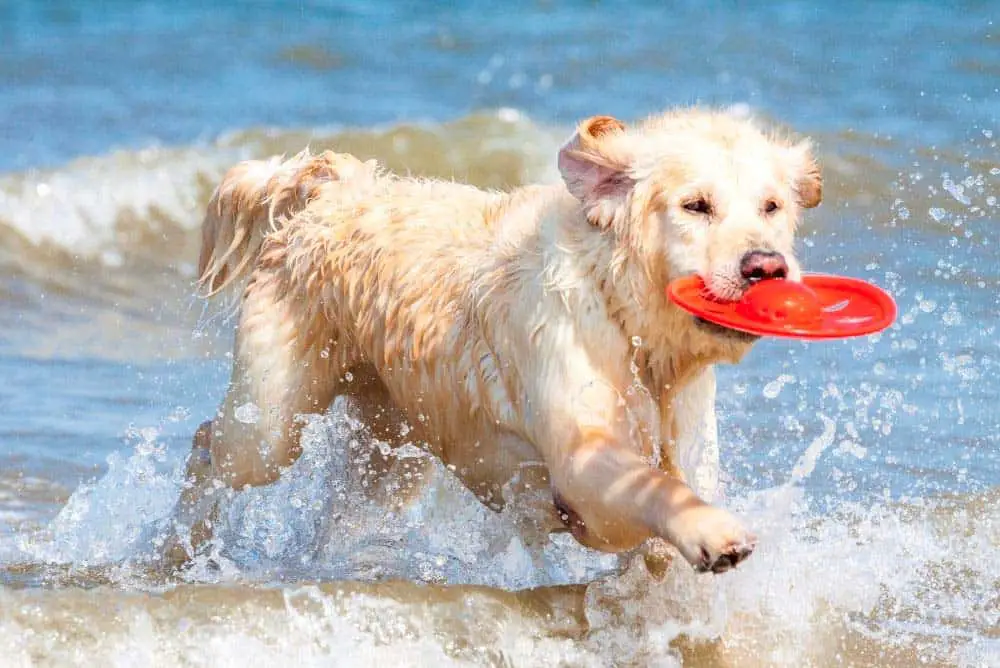
Light Golden Retrievers are the second most popular preference when it comes to Retrievers. This breed makes a great family pet or a show dog, as they are allowed in dog shows with the AKC and UK Kennel Club.
Most people will have trouble telling the difference between a light Golden and a traditional Golden Retriever since they are lighter than the standard gold color but darker than a cream. They look like lighter colored traditional Golden Retrievers, hence their names.
This variation of the Golden Retriever has the same temperament, intelligence, and energy levels of other Retrievers. They also have similar size, with males ranging from 65 to 75 pounds and 23″ to 24″; females are 55 to 65 pounds and 21.5″ to 22.5″ in height.
Retrievers typically reach full height by their first birthday and total weight by the age of two.
Traditional Golden Retrievers
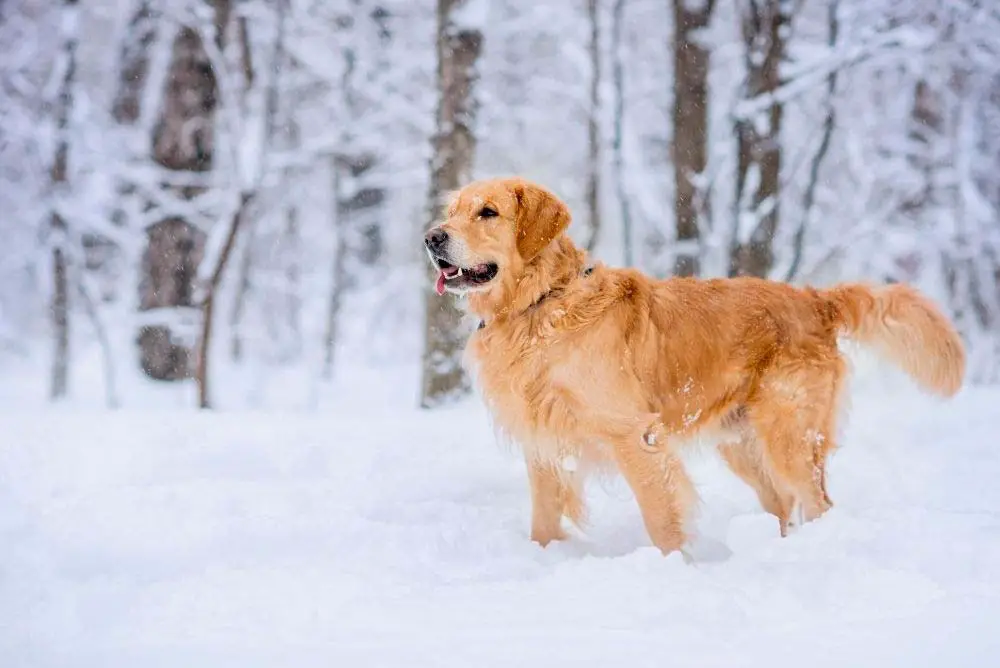
The traditional Golden Retriever has a solid coat of warm honey gold-colored double layer fur. Their long, shiny golden locks need daily grooming to prevent messy shedding.
The only difference between a traditional Golden Retriever coat and those of other Retrievers is the color of the fur. They have a similar size and weight, facial structure, and coating.
The personality and energy are also the same for all variants of Golden Retrievers.
Differences Between a Dark and a Traditional Golden Retriever
Compared to the tall, broad-chested size of a traditional Retriever, dark Golden Retrievers have a compact, leaner body build. Their skin is thicker than their counterparts, making them excellent for hunting and outdoor adventures.
The coat will be thick and luscious like a traditional, but the fur will be slightly shorter and a bit thinner. And the tail will not have as much fluff and frizz.
The variation of the fur color does not mean that your pet will have a different personality than a light Golden Retriever. The size will be similar. Males grow to around 65-75 pounds and 22″ to 24″ height and 20″ to 22″ height and 55 to 65 pounds for females.
Although their generall personality is the same, Dark Retrievers tend to socialize a bit less than traditional Goldens, but they do have a higher intelligence and energy level. And, they are also easier to train than other colored Retrievers.
How to Determine the Future Coat Color of a Golden Retriever Puppy
If you are planning to enter your Golden Retriever into competitions or just have a particular coat color preference, it may be essential for you to know what color your puppy will be as a full adult.
It can be challenging to determine the color of the puppy as an adult just by looking at the parents. Many dark-coated parents can produce light-colored puppies, depending on their bloodline. Light golden brown dogs tend to produce light coated puppies.
The best way to determine the color a puppy will turn out to be when grown is to look at the ears. If your puppy’s ears are darker than their body, it’s a sign that their coat will darken as they age. But if your puppy’s ears are light, the coating will stay light at full maturity.
As your puppy ages, the coat may change slightly, depending on the shade of the ears. Once they reach one year of age, their coat should be at its permanent color.
As your dog enters its senior years, the hair around the muzzle and eyes can start to turn gray. If your dog starts to turn gray all over, you may want to consult a veterinarian.
Older dogs do require more grooming than younger dogs. And their bellies frequently turn black or blueish (it’s referred to as blueberry belly and is perfectly normal). This discoloration is a sign of excellent pigment and is a good sign instead of a bad one.
Grooming Needs of Golden Retrievers
Golden Retrievers have a double coat, meaning two layers of fur. The top layer is soft and long, while the underlayer is thick and dense. Double coats mean more shedding.
In the colder months, your Retriever’s fur will thicken. The undercoat will keep your dog warm in cold weather, but this hair will fall out when the weather turns warm.
Be prepared for heavy shedding in the spring to early summer. Having a good grooming routine can reduce the amount of stray hair that will accumulate around your home, furniture, and clothing.
Brushing
Golden Retrievers benefit from frequent brushing using a high-quality bristle brush for the top and a metal undercoat rake for the thick fur under the stomach and neck. This self-cleaning bush from Amazon is perfect for removing the loose undercoat. Your golden will love getting brushed with this brush.
In heavy shedding times, you may find yourself brushing your dog a few times a day. During regular sheds, once a day or less will suffice.
Bathing
Besides regular brushings, Golden Retrievers also need frequent baths. Bathing a Retriever isn’t as challenging as other breeds because this breed loves the water.
Wash your pet using dog shampoo as often as you and your pet desire. The fur and skin will not suffer from too much exposure to water like some other breeds. You may want to try this Lavender Oatmeal shampoo (Amazon) for dogs and puppies as it not only smells great, it will also help relieve any itching your dog may experience.
Cutting
Retrievers should not get shaved. But they do require regular hair trims, especially along the feet. You also need to trim inside and on top of the ears and along the tail. The rest of your pet’s coat will not need cutting.
But some people do perform some slight trimming of the undercoat. We recommend this helpful step-by-step guide to help you learn how to do proper cutting of your Golden Retriever. And we suggest you should only attempt trimming of the bottom layer if necessary.
Many Retrievers grow “slippers”, which is when the fur grows over the paws. This fur should stay cut short, like that of cat feet. Also, be sure to keep the hair between the pads of the feet trimmed down using a pair of grooming shears.
Ear Care
In addition to trimming the hair on the tops of the ears, you also need to keep the hair thinned on the inside of the ear. As goldens are prone to ear infections, trimming the hair on the inside of their ear helps to air out their ear canals.
Plus, your Retriever also needs frequent ear cleanings. To avoid ear infections, it’s best to clean your Goldens ears on a regular basis before there is a problem.
Be sure to use a quality product like Vibac Epi-Otic Advanced Ear Cleaner (Amazon). It’s mild, pH balanced, and alcohol free. Your pup will thank you!
Kennel Club Standards for Golden Retrievers
For a dog to participate in dog shows hosted by the American Kennel Club, they have to meet the club’s specific standards.
According to the guidelines, a Golden Retriever coat has to be a rich gold with various shadings. This rule automatically disqualifies Goldens with coats that are “extremely light” or “extremely dark.”
Golden Retrievers with coats that contain pure white, black, or copper coloring are not considered to be true Golden Retrievers and will not be allowed in shows (the same holds true for Golden Retrievers with blue eyes). Cream coated Golden Retrievers are also not allowed, nor are red shaded coats. But the final decision on your dog’s eligibility depends on the judge.
Cream-colored coats are permitted in the UK Kennel Club, showing circles, as cream Golden Retrievers are more prevalent in Europe. Red or mahogany colored coats are still not allowed.
Canada Kennel Club (CKC) does not have as many restrictions on coat colors and accept dark or light gold coloring as long as it’s within range of medium gold.
Types of Golden Retrievers
Golden Retrievers are a medium breed dog with a high activity tolerance and a dense gold coat for which it got its name. This breed is extremely intelligent, with a fluffy tail and a love for sharing affection and loyalty.
Retrievers are also easy to train and have a high energy level that makes them love spending time being active outdoors. Their favorite activities are swimming and fetching, which makes them ideal hunting companions.
There are three distinct types of Golden Retrievers. Despite having different origins and coloring, there is little difference between the three types. The three types are:
- American Golden Retriever
- English (or British) Golden Retriever
- Canadian Golden Retriever
Although there are slight differences between all three of these breeds, most people unfamiliar with each particular kind would be unable to distinguish the differences.
American Golden Retrievers
The American Golden Retriever is one of the most popular choices for a family companion. This breed has multiple small differences from other Retrievers.
For one, the American Retriever has a smaller size. The body is lankier, with less prominent muscle buildup. They also have a different gait, or way of walking, with free, smooth, and well-coordinated movements.
Plus, they have different shaped eyes. American Golden Retrievers have a triangular or slanted eye shape.
When it comes to color, American Retrievers generally have darker coat colors. Even the signature light gold shade of Golden Retrievers will be a darker tone.
Physical Size
For a dog to classify as an American Golden Retriever, they have to meet specific physical requirements. The American Kennel Club has determined these standards.
The skull of an American Golden Retriever should be a smooth slope from the tip of the snout to the back of the head. There should not be any bulges, knots, or abnormalities, especially along the forehead. The eyes should not appear sunken into the sockets.
An American Golden Retriever should not have barrel-shaped ribs or abnormalities along the topline. The front and back legs should have a slightly muscular build. And the pelvic bone should sit at a 30-degree angle from the horizon.
English Golden Retrievers
English Golden Retrievers originated in Scotland and are widely popular in Europe. Also referred to as English Cream Golden Retrievers or British Golden Retrievers, there are minimal physical differences between this type of Retriever and an American.
To determine if a Retriever is an English or British Golden Retriever, you’ll need to examine three specific areas of your dog.
English Retrievers have a broader skull, with a chiseled muzzle. The color of an English is usually lighter. Many English Retrievers have a cream coat, which is a very light off-white shade. But even the golden shades will be lighter than the other two Retriever types.
The final difference between an English and an American or Canadian Golden Retriever is all in the eyes. British Retrievers have rounder eyes and a darker eye color.
Canadian Golden Retrievers
We haven’t talked much about Canadian Golden Retrievers, so let’s rectify that now. There are three noticeable differences that can tell you whether a dog is a Canadian Golden Retriever or an American or English.
Canadian Golden Retrievers have fur that is shorter and thinner than the other two types. The coat is also denser, which is useful for the colder winter months. And finally, Canadian Retrievers are taller than their kinfolk. They can grow up to two inches taller.
Despite the differences in appearance, all Golden Retrievers have the same loyal and friendly disposition. They are also all matched with their energy levels. Retrievers need 40 to 60 minutes of exercise a day to keep them healthy and from being destructive.
Differences Between the American and the English Golden Retriever
Besides coat color, there are a few other differences between the American and English Golden Retrievers. Cream (English) Retrievers have a slimmer body with sleeker fur that doesn’t have as much poof as the American Retriever. But they have the same personality.
There is a notable size difference between male and female English Retrievers compared to different genders of the American Golden Retriever. Cream Retrievers are often a bit shorter than their American relatives.
Other different physical features include the face, ears, and tail. The eyes of a cream Retriever are usually rounder than American Retrievers and darker shades.
The head of an English Retriever is usually broader, with a chiseled, wide, deep muzzle. With cream Retrievers’, the ears set forward on the head more than American Retrievers.
They have a level back and tail. English Retrievers also usually have a stockier build, with broader heads and longer necks.
Golden Retriever History
The Golden Retriever breed originated in Scotland in the 19th century. The first Lord of Tweedmouth, Dudley Marjoribanks, decided he wanted to create a new kind of dog to help retrieve game that fell at long distances from the shooter and to get objects out of the water.
To create a Retriever, the Lord crossbred a yellow Retriever with a Tweed Water Spaniel (now extinct). This matching resulted in four puppies, which were then bred to other breeds such as the Bloodhound and Irish Setter.
Fifty years later, the first breed of Golden Retriever was born. This type of dog loved the water and had a thick water-resistant double coat that made it ideal for cold climates and foul weather.
This breed also had a good-natured personality, keen intelligence, and steady obedience. Their high energy levels and Bloodhound ancestry made them perfect as hunting companions.
Modern Day Golden Retrievers
The first appearance of the Golden Retriever in Britain was at a dog show in 1908, and it became a recognized breed in Britain around 1913.
The Retriever appeared in the US by way of Canada around the same time as it became popular in Europe. But America didn’t adopt the breed standards until 1925.
In the 1970s, President Ford brought the breed into the limelight, and families around the world fell in love with the sweet look of a Golden Retriever. People quickly fell in love with the Golden Retriever and it became the essence of the perfect American family pet.
Today, Golden Retrievers are still used as hunting companions. But they are more often found as loyal and friendly family companions. This gentle breed loves to be part of a large pack and is one of the best breeds to have around small children.
Golden Retrievers have also become a favorite breed to train as service animals for people with visual or hearing impairments. They are also excellent therapy and emotional support dogs.
And due to their size and stamina, Golden Retrievers are also often trained to be search and rescue dogs to assist with water rescues. They can also be used to track missing persons and help with natural disasters or mass casualties.
There really isn’t anything these dogs can’t do! Except for acting as a watchdog, perhaps. Their friendly demeanor means they’re more likely to lick an intruder to death after barking a few times rather than guard your home.
Characteristics of a Golden Retriever
Golden Retrievers are a medium-sized dog known for being gentle, easy to train, intelligent, and intensely loyal, making this breed highly sought after by families big and small.
Their patience and good temper mean these dogs won’t become snarky or aggressive if a young child happens to pull their tail or lie on their backs.
According to the American Kennel Club, out of all the dog breeds, the Golden Retriever is the third most popular after Labrador Retrievers and German Shepherds.
These dogs are also low maintenance and easy to care for, so they don’t require a lot of upkeep, besides simple grooming, daily exercise, and a balanced diet.
But they do shed a lot, so if dog hair everywhere bothers you, or you have an allergy to pet dander, you might want to consider another breed besides a Golden Retriever.
Golden Retrievers love the water, so they’re great pets to have if you spend a lot of time at the beach or lake or looking for a companion to go along on hunting trips. Their high energy level also makes them excellent partners for long hikes in rural areas.
And Retrievers are so friendly and loving that they get along with strangers, the entire family, and even other pets. If you’re looking for a new family pet to add to your mongrel of other dogs or cats, a Golden Retriever could be the right choice for you!
In Closing
There are three types of Golden Retrievers with small differences among them. A person unfamiliar with the breed will not be able to identify the exact bloodline.
Three ways that these dogs differ is in size, coat type, and eye shape. The three types of Retrievers are American, English, and Canadian. The colors can vary between cream, light or dark gold, and red.
More Golden Retriever Articles You’ll Love!
- How to Take Care of Your Golden Retriever’s Coat: Step-by-Step
- The 19 Best Toys Golden Retrievers Will Actually Play With!
- How Much Space Does a Golden Retriever Need? (Explained!)
- Male vs. Female Golden Retriever – Is There a Difference?
Sources
- AKC: Most Popular Dog Breeds: Dog Breed Popularity 2018
- All-About-Goldens: Golden Retriever Colors
- Absolutely Golden: Grooming Your Golden
- Golden Retriever Club of America: English Cream Golden Retrievers
- Morningsage Golden: Grooming Your Golden ~ The Ears
- Morningsage Golden: Grooming Your Golden ~ The Feet
